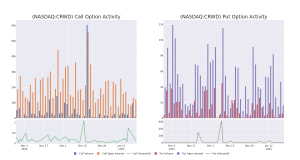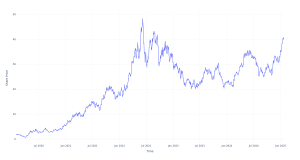
Investors love index funds with good reason. They allow for easy diversification and typically feature low expenses. For patient investors, broad index funds might perform better than most actively managed funds because that management is more expensive and because it is so difficult to select index-beating portfolios consistently.
But with the S&P 500 SPX having returned 36.4% over the past year through Sept. 30, warnings to investors typically center on two subjects.
Most Read from MarketWatch
The first is valuation. The index trades at a forward price-to-earnings ratio of 21.6, based on Monday’s closing prices and weighted consensus earnings-per-share estimates among analysts polled by FactSet. That is up from a forward P/E of 18 a year ago, and well above the 10-year average forward P/E of 18.3, according to data provided by FactSet.
The second warning is about the concentration of the large-cap U.S. benchmark index. The S&P 500 is weighted by market capitalization. On Monday, the portfolio of the SPDR S&P 500 ETF Trust SPY, the oldest and largest exchange-traded fund tracking the index, was 20% allocated to three companies: Apple Inc. AAPL, Microsoft Corp. MSFT and Nvidia Corp. NVDA. These were its top five holdings, which made up 26% of the portfolio:
|
Company |
Ticker |
% of SPY portfolio |
One-year total return through Sept. 30 |
|
Apple Inc. |
AAPL |
7.3% |
37% |
|
Microsoft Corp. |
MSFT |
6.6% |
37% |
|
Nvidia Corp. |
NVDA |
6.1% |
179% |
|
Amazon.com Inc. |
AMZN |
3.6% |
47% |
|
Meta Platforms Inc. |
META |
2.6% |
91% |
|
Source: FactSet |
|||
SPY was established in January 1993 and has $591 billion in assets under management.
All total returns in this article include reinvested dividends and are net of expenses.
The S&P 500’s weighting by market cap rewards success, but it can also lead to an index fund’s investors having more of their money concentrated in a handful of stocks than they might realize.
Different weighting and selection within the S&P 500
One obvious way to counter a cap-weighted index is to allocate equally. Since share prices move daily, the Invesco S&P 500 Equal Weight ETF RSP is rebalanced quarterly. The equal weighting leads to more of a value tilt, as the technology giants at the top of the index, with such strong sales growth for a company such as Nvidia, all have equal weighting, even to companies that are growing at a snail’s pace. This makes for differentiated performance. For example, in 2022, when SPY was down 18.2%, RSP fell only 11.6%. But when SPY roared back with a 26.2% return in 2023, RSP rose 13.7%.
Invesco has several other methods for alternative weightings to the S&P 500, and factor-based strategies to track indexes that select from within the index.
For a comparison of long-term performance, we limited the list to Invesco S&P 500 Factor ETFs that were established more than five years ago. In addition to comparing the factor ETFs’ performance with SPY, we compared them with the Vanguard S&P 500 ETF VOO, which was established in September 2010 and has $509 billion in assets under management. SPY’s annual expenses come to s 0.0945% of average assets under management, while VOO’s expense ratio is 0.05%.
The following tables have performance comparisons for SPY, VOO and nine of Invesco’s factor funds that have existed for more than five years. The first table shows total returns and the second table shows average annual returns.
The two broad S&P 500 index funds are at the top of each table. Then the Invesco S&P 500 Quality ETF is listed next because it is the only one of the factor ETFs that has existed for more than 15 years. After that, the list is sorted by five-year returns.
Any bolded number for the factor ETFs means its return for that period was higher than those of SPY and VOO.
First, total returns:
|
ETF |
1-year return |
3-year return |
5-year return |
10-year return |
15-year return |
|
SPDR S&P 500 ETF Trust SPY |
36.0% |
39.8% |
109.0% |
247.7% |
618% |
|
Vanguard S&P 500 ETF VOO |
36.3% |
40.1% |
109.4% |
249.8% |
N/A |
|
Invesco S&P 500 Quality ETF SPHQ |
36.2% |
45.1% |
117.3% |
269.7% |
710% |
|
Invesco S&P 500 Momentum ETF SPMO |
59.1% |
56.4% |
138.4% |
N/A |
N/A |
|
Invesco S&P 500 GARP ETF SPGP |
16.4% |
24.9% |
97.3% |
267.1% |
N/A |
|
Invesco S&P 500 Revenue ETF RWL |
27.5% |
41.4% |
98.3% |
204.3% |
557% |
|
Invesco S&P 500 Equal Weight ETF RSP |
28.5% |
25.8% |
81.1% |
180.4% |
514% |
|
Invesco S&P 500 Pure Growth ETF RPG |
30.9% |
4.4% |
71.3% |
170.7% |
587% |
|
Invesco S&P 500 Low Volatility ETF SPLV |
24.8% |
25.9% |
37.9% |
154.8% |
N/A |
|
Invesco S&P 500 High Dividend Low Volatility ETF SPHD |
34.4% |
34.8% |
46.8% |
146.3% |
N/A |
|
Invesco S&P 500 Pure Value ETF RPV |
23.7% |
25.9% |
54.8% |
110.9% |
422% |
|
Source: FactSet |
|||||
And now, the average annual returns:
|
ETF |
1-year return |
3-year avg. return |
5-year avg. return |
10-year avg. return |
15-year avg. return |
|
SPDR S&P 500 ETF Trust SPY |
36.0% |
11.8% |
15.9% |
13.3% |
14.0% |
|
Vanguard S&P 500 ETF VOO |
36.3% |
11.9% |
15.9% |
13.3% |
N/A |
|
Invesco S&P 500 Quality ETF SPHQ |
36.2% |
13.2% |
16.8% |
14.0% |
15.0% |
|
Invesco S&P 500 Momentum ETF SPMO |
59.1% |
16.1% |
19.0% |
N/A |
N/A |
|
Invesco S&P 500 GARP ETF SPGP |
16.4% |
7.7% |
14.6% |
13.9% |
N/A |
|
Invesco S&P 500 Revenue ETF RWL |
27.5% |
12.3% |
14.7% |
11.8% |
13.4% |
|
Invesco S&P 500 Equal Weight ETF RSP |
28.5% |
7.9% |
12.6% |
10.9% |
12.9% |
|
Invesco S&P 500 Pure Growth ETF RPG |
30.9% |
1.5% |
11.4% |
10.5% |
13.7% |
|
Invesco S&P 500 Low Volatility ETF SPLV |
24.8% |
8.0% |
6.6% |
9.8% |
N/A |
|
Invesco S&P 500 High Dividend Low Volatility ETF SPHD |
34.4% |
10.5% |
8.0% |
9.4% |
N/A |
|
Invesco S&P 500 Pure Value ETF RPV |
23.7% |
8.0% |
9.1% |
7.7% |
11.6% |
|
Source: FactSet |
|||||
It is no surprise that VOO has beaten SPY slightly for all periods going back to 10 years, because of VOO’s lower expenses.
For the full 15-year period, the Invesco S&P 500 Quality ETF SPHQ has been the best performer. It has beaten SPY for all periods on the tables and has beaten VOO for all periods except for the one-year period through Sept. 30. SPHQ holds the 100 stocks among the S&P 500 that rank highest according to a quality score that combines returns on equity, debt to book value and an “accruals ratio” of operating assets to total assets. The indexes for all of these ETFs are maintained by S&P Dow Jones Indices. The index tracked by this fund is rebalanced twice a year, with other adjustments made immediately after spinoffs or if a company is removed from the S&P 500. Each stock is weighted by the product of its quality score and its market capitalization. SPHQ is rated five stars (the highest rating) within Morningstar’s “U.S. Blend Large Fund” category. Its expense ratio is 0.15%.
The other notable outperformer among these S&P 500 factor ETFs has been the Invesco S&P 500 Momentum ETF SPMO, which was established in October 2015. It outperformed SPY and VOO for the one-, three- and five-year periods through Sept. 30. This fund currently holds 99 stocks of companies within the highest “momentum scores.” Twice a year, the components of the S&P 500 are ranked by how much their prices have risen over the previous 12 months, then scored to take volatility into account. The portfolio is made up of the 20% of companies in the S&P 500 that score highest, then weighted by a combination of the momentum score and market capitalization. This fund also has a five-star rating from Morningstar, within the investment information provider’s “U.S. Fund Large Growth” category. It has a 0.13% expense ratio.
These factor ETFs “will shine most brightly during different parts of the economic cycle,” according to Nick Kalivas, who heads Invesco’s factor strategy for exchange-traded funds.
During an interview with MarketWatch, he said a particular advantage of the S&P 500 Momentum ETF was that it could be less affected by broad market cycles, because of its weighting toward stocks that have performed well recently.
He added that a combination of approaches to indexing “can be helpful for portfolio management because they work at different times” within market and economy cycles.
Here’s a summary of the other seven listed Invesco factor funds, leaving them in the same order as on the tables:
Don’t miss: 14 energy stocks whose ample cash flow might benefit shareholders


